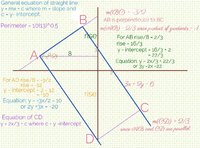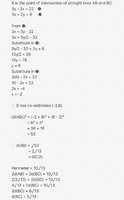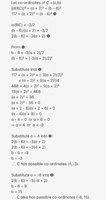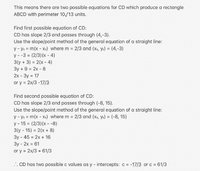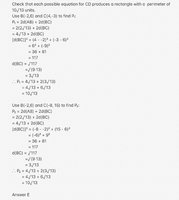Problem: Suppose you are making a rectangle with the following constraints:
1. One line segment is described by the equation 3x+2y=6
2. One of the vertices must be (-8,2). This gives the equation of two more lines
3. To get the last equation, consider the perimeter of the rectangle is 10√13 units.
If you are tasked with finding the equations of all four lines, what does not need to be used?
a. Distance Formula
b. Substitution
c. Slope-intercept form
d. Slope formula
e. All of the above are used
I went ahead and tried to solve all 4 equations. The first one is given, and the second and third can be found by using the reciprocal slope and using the points given.
L1: y=(-3/2)x+3
L2: y=(2/3)x+(22/3)
L3: y=-(3/2)x-10
Using the distance formula, you know that distance between the points (-8, 2) and (-2, 6) is 2√13, so those parallel sides of the rectangle are 4√13 of the total 10√13, so the other two sides must be 3√13 each. I know the slope of the 4th line will be (2/3)x, but I am unclear of how to solve the equation so that it fits the parameters.
As for the answer, I'm also a bit confused. In my way I substituted values into the slope intercept form to get the new equations, but I didn't solve a system of equations using substitution, not sure if that's what the problem means.
So my question is, how do I find the equation for the 4th line, and what would be the correct answer? I want to answer D, slope formula just because I didn't count a certain number of units up or down, then a certain number of units left of right, but I'm not sure if that's what they mean by the slope formula. Kind of a weird questions imho.
1. One line segment is described by the equation 3x+2y=6
2. One of the vertices must be (-8,2). This gives the equation of two more lines
3. To get the last equation, consider the perimeter of the rectangle is 10√13 units.
If you are tasked with finding the equations of all four lines, what does not need to be used?
a. Distance Formula
b. Substitution
c. Slope-intercept form
d. Slope formula
e. All of the above are used
I went ahead and tried to solve all 4 equations. The first one is given, and the second and third can be found by using the reciprocal slope and using the points given.
L1: y=(-3/2)x+3
L2: y=(2/3)x+(22/3)
L3: y=-(3/2)x-10
Using the distance formula, you know that distance between the points (-8, 2) and (-2, 6) is 2√13, so those parallel sides of the rectangle are 4√13 of the total 10√13, so the other two sides must be 3√13 each. I know the slope of the 4th line will be (2/3)x, but I am unclear of how to solve the equation so that it fits the parameters.
As for the answer, I'm also a bit confused. In my way I substituted values into the slope intercept form to get the new equations, but I didn't solve a system of equations using substitution, not sure if that's what the problem means.
So my question is, how do I find the equation for the 4th line, and what would be the correct answer? I want to answer D, slope formula just because I didn't count a certain number of units up or down, then a certain number of units left of right, but I'm not sure if that's what they mean by the slope formula. Kind of a weird questions imho.

